
Above: Kellan Lutz in Renny Harlin's Hercules 3D
Both Kellan Lutz and Dwayne Johnson have Hercules films coming out next year, in the spring and summer, respectively. Sure seems a long time to wait, huh? So to kill some time until then, we thought we'd dig into the myth and love life of the most famous alpha male of all time. Do you think Dwayne and Kellan know they are playing bisexual?

Above: Dwayne Johnson in Brett Ratner's Hercules: The Thracian Wars
Get the lowdown on Hercules's love life with the guys on the following pages >>>
 Above: Roman sarcophagus depicting the several of the Labors of Hercules -- the defeat of the Cretan Bull and Horses of Diomedes. Sure is a lot of horn on that bull.
Above: Roman sarcophagus depicting the several of the Labors of Hercules -- the defeat of the Cretan Bull and Horses of Diomedes. Sure is a lot of horn on that bull.Mythology is a tricky business. Basically, it's gossip created by the unconscious minds of the ancients, formed into fables, then told and and retold until it barely resembles the original source material. And that's the way it should happen, because with each retelling and each revision (that sticks) it becomes closer and closer to a mythic truth that explains nature, psychology, and sexuality, among many other things.
Then two things happened that kind of ruined it for mythology: science and Christianity. Science explained the cold hard facts of the physical world, and Christianity had big issues with the freewheeling sex lives of the gods and demigods. So now we know that constellations of stars are random and unplanned, and the natural chaotic sexuality of the universe has been whitewashed by the current religious establishment.
 Hercules depicted by Hendrick Goltzius in the late 1500s. Goltzius gives us a somewhat anotomically fantastic Hercules tending more toward the leather daddy spectrum. Those nipples have seen some mileage.
Hercules depicted by Hendrick Goltzius in the late 1500s. Goltzius gives us a somewhat anotomically fantastic Hercules tending more toward the leather daddy spectrum. Those nipples have seen some mileage.One of the first sexual aspects to go once the Christians were in charge was same-sex love. It wasn't homosexuality then, it was just sexuality. There were certain customs and cultural expectations around same-sex attractions, of course, but none of them had to do with it being considered an abomination.
Each academic revision of the ancient texts has drained them further and further of some very important juice. That's why, if in modern texts there is even a hint of a same-sex storyline, you can probably bet some Christian scholar has dulled it down and that the original is more wonderfully gay than the version we have now. In both history and mythology, any passages dealing with same-sex attractions have been systematically censored for centuries.
 Above:
Above: Drunken Hercules,
detail, c. 1611, by Peter Paul Rubens. Must have been some party. Looks like the ladies and the satyrs both got a piece of the "Gee, I must have been a drunk demigod last night" action.
Above: At the Musei Capitolini in Rome, a statue of Heracles (Hercules) killing the Lernaean Hydra. Marble, Roman copy from a Greek original of the fourth century B.C.; restored c. 1635. Careful, Herc, that Hydra is awful close to the business.

Above: More snakes, some museum, somewhere.
 Left: Mid-century gay artist George Quaintance certainly knew that sometimes a Hydra is more than a Hydra.
Left: Mid-century gay artist George Quaintance certainly knew that sometimes a Hydra is more than a Hydra.
Battles with serpents, snakes, and other phallic forms play freely in the subconcious mind. Is a serpent ever just a serpent? Seems fitting that Hercules was wrestling snakes when he was just an infant. He went on to other legendary phallic battles: His slaying of the Hydra (nine heads!) was one of the 12 Labors of Hercules.
If you study the Hercules myth you will find that both the Greeks (Heracles) and Romans (Hercules) had very similar but slightly varying tales of his parentage and love life, but in both he is a demigod, a child of one god and one human.
He was also fairly erratic. We would say 'roid rage now, but we doubt there was an ancient Greek version of Biogenesis. Suffice it to say he murdered his first three sons while in a very bad mood. But heroes play fast and loose with the rules. We see this in the modern-day equivalent of the gods: professional athletes.
Antaeus and Hercules: Swept Off His FeetLegend has it that Antaeus would challenge all passers-by to wrestle. He would kill them and then use their skulls to build a temple to his father, Poseidon. He was superhumanly strong as long as he kept his feet on the ground, but once lifted into the air he became as vulnerable as other men.
Antaeus had defeated most of his opponents until it came to his fight with Hercules (who was on his way to the Garden of Hesperides for his 11th Labor). Upon finding that he could not beat Antaeus by throwing him to the ground, Hercules discovered the secret of his power. Holding Antaeus aloft, Hercules crushed him in a bear hug. The struggle between Antaeus and Hercules is a favorite subject in ancient and Renaissance sculpture and painting. Depictions of Antaeus with his legs in the air were also found in many gay men's homes in the last century as a sort of visual code to visitors that they belonged to "the club."

Hercules and Antaeus by Antonio Del Pollaiuolo. A bit grim, but some nice butt crack.

Antaeus looks pretty earthbound here, but he is surrendering to some apparent hair-pulling. Antoine Coypel's version of Hercules and Antaeus, 1667-1669.

Fuente de Hercules y Anteo, Jardin del Parterre Aranjuez, Madrid. When this fountain is active, water spurts from Antaeus' mouth. Cute.
 Gregorio de Ferrari, Hercules and Antaeus, 1690s
Gregorio de Ferrari, Hercules and Antaeus, 1690s
Hercules and Antaeus by Antoine Jean

Hercules and Antaeus, Andrea Mantegna, 1497
 Louis Charles Auguste Couder,
Louis Charles Auguste Couder, The Earth,
or The Fight Between Hercules and Antaeus
, 1819.
This is perhaps the most luscious of all the versions of this myth that we could resource.There is no overtly homosexual side to the story of the battle between Antaeus and Hercules, yet the consistent voluptuousness of the various versions is hard to deny with modern eyes. One man is being dominated by the other, naked sweaty bodies rubbing against each other. Legs flailing in air. The rapturous surrender and the focus on the vulnerable buttocks is hard to miss.
Hercules and Diomedes: That StatueFinding trustworthy source material on why exactly Diomedes has grabbed the goods here is tough. The basic story takes place after the Eighth Labor.

Above: That this statue makes a lot of folks giggle may be a testament to the humor of the Greeks and Romans. This is another example of a sculpture found in gay men's homes in the middle of the last century -- sometimes as a lamp base.
Ares' son, Diomedes, King of the Bistones, in Thrace, offers newcomers to his horses for dinner. When Hercules and his friends arrive, the king decides to feed them to the horses, but Hercules turns the tables on the king after a wrestling match -- prolonged because it is with with the war god's son. Prolonged. Penis. Grabbing.
In some versions of this story Hercules loses his young lover, Abderus. Hercules leaves Diomedes's horses in the care of Abderus. While Hercules is away, the horses devour Abderus. In revenge, Hercules feeds Diomedes' still-living flesh to his own mares. Hercules founded the city of Abdera near the boy's tomb, where athletic games were held in honor of Abderus.
 Hercules, Iolaus, and Eros, Cista Ficoroni
Hercules, Iolaus, and Eros, Cista FicoroniHercules was also a legenday stud with the ladies. Invited by King Thespios to stay at his palace before a hunt and "meet the family," Hercules deflowered 49 of the king's 50 daughters in one night. Nine months later, Hercules had 49 new kids.

Above: Hercules and Iolaos after the capture of the Erymanthian boar. Mosaic from a fountain from Neronian times (ruled 54 to 68 C.E.), now located in the Palazzo Massimo, Rome.
His love life with the boys is no less active. Custom was that most male same-sex relationships were between men and boys (not children -- young men of the age of legal consent in modern Greece today would be about the same age). These boys often went on to marry and have children. These were not solely sexual relationships - they were deep and devoted friendships full of love and passion, but probably less insertive than what the modern-day gay man would expect.

Above: Hermann Wilhelm Bissen, Hylas, 1846
Plutarch, the Greek historian (and eventual Roman citizen), wrote that Hercules' list of male lovers was beyond numbering. Among his lovers were said to be the young heroes Admetos, Iphitos, Euphemos, Elacatas, and Abderus, son of Hermes, whose love for Hercules cost him his life (see above). Also Nireus, Adonis, Jason, Corythus, Stychius, and Phrynx.
Male love may be central to the 12 Labors of Hercules as well. In some academic circles there are rumored versions of the story pairing Hercules and King Eurystheus, the man for whom he performed the Labors.

Above: Philoctetes, by Nikolaj Abraham Abildgaard, 1775
Notable standouts in his love stable were Philoctetes, who upon Hercules' death inherited his bow and arrows, and Nestor, the youngest son of King Neleus.
Of all his loves, Iolaos of Thebes and Hylas of Argos still have slivers of contemporary academic recognition as friends and lovers. Iolaos was also his nephew and, though still a youth, assisted in his Labors. It was said that Hercules performed his Labors with pride when Iolaos watched.
According to Plutarch, "But those who think that Iolaos was one of them do to this day worship and honor him, and make their loved ones swear fidelity at his tomb." Plutarch also wrote, "And Aristotle observes that even in his time lovers 'pledged their faith at Iolaos' tomb.'" The Thebans thought so highly of Iolaos that they worshipped him together with Hercules and named their gymnasium after him.
 Above: John William Waterhouse,
Above: John William Waterhouse, Hylas and the Nymphs,
Manchester Art Gallery, 1896 In Greek mythology, Hylas was the son of King Theiodamas of the Dryopians. Roman sources such as Ovid state that Hylas' father was Hercules and his mother was a nymph. In other versions Hylas is not his son, making their legendary relationship a bit more palatable.
In Greek mythology, Hylas was the son of King Theiodamas of the Dryopians. Roman sources such as Ovid state that Hylas' father was Hercules and his mother was a nymph. In other versions Hylas is not his son, making their legendary relationship a bit more palatable.
At left: Hylas being abducted by some fairly formidable nymphs.
The poet Theocritus (c. 300 B.C.) wrote about the love between Hercules and Hylas: "We are not the first mortals to see beauty in what is beautiful. No, even Amphitryon's bronze-hearted son, who defeated the savage Nemean lion, loved a boy -- charming Hylas, whose hair hung down in curls. And like a father with a dear son he taught him all the things which had made him a mighty man, and famous."
While traveling for battle Hylas was kidnapped by nymphs in a spring. The nymphs fell in love with him -- a scene that has been depicted in many artistic renderings. He vanished without a trace.

Above and below: Hercules the Archer, by Emile-Antoine Bourdelle

Modern-Day Hercules

Clockwise from upper left: Arnold Schwarzenegger in Hercules in New York (1969), notably Arnold's first film feature; Hercules by Don Heck, 1967, based on Steve Reeves; The spectacular Lou Ferrigno in Hercules (1983); Physique mag Adonis, most likely depicting Adonis and lover Hercules.
Modern-Day Hercules
Clockwise from upper left: A Disney-fied Hercules; Kevin Sorbo as Hercules (left) and Michael Hurst as Iolaus (right) in the 1995 television series Hercules: The Legendary Journeys; 1313 Hercules Unbound (don't ask); Reg Park, notably on record as the first bodybuilder to bench press 500 pounds. As an actor, Park made five films -- all Italian Hercules sword-and-sandal epics.

Above: Editor's choice for the best modern-day Hercules: Steve Reeves. At the peak of his carrer he was the highest-paid actor in Europe. In 1957, Reeves went to Italy and played the lead character in Pietro Francisci's Hercules. The film was a success, grossing $5 million in the United States alone in 1959. Its commercial success led to a 1959 sequel, Hercules Unchained.

Above: Hendrick Goltzius, Farnese Hercules, 1592
A perfect parting shot of Goltzius's etching of the ancient Roman statue known as the Farnese Hercules, which had been discovered in the Baths of Caracalla in Rome in 1546 and installed in a courtyard of the Farnese family's palace on the banks of the Tiber.
There is not one thing about this etching that is not supergay, from the incredible rendering of the muscles to the modern-day queens peering up from the right to the astoundingly phallic (uncut as well) pediment that Hercules rests on. For an even more breathless account of this statue and engraving, see this page at the Metropolitan Museum of Art.
Sources: Gay-Art-History.org, the Metropolitan Museum of New York, The Getty Center, Wikipedia









 Left: Mid-century gay artist George Quaintance certainly knew that sometimes a Hydra is more than a Hydra.
Left: Mid-century gay artist George Quaintance certainly knew that sometimes a Hydra is more than a Hydra.









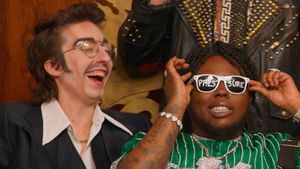


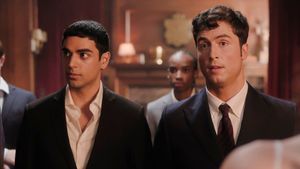


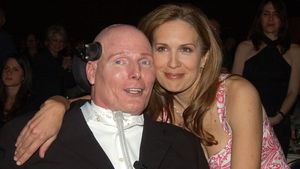








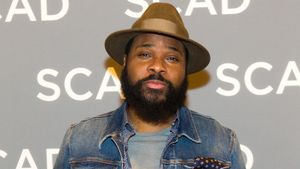


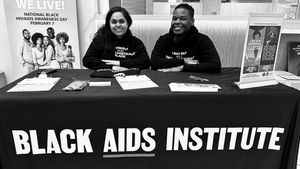














 In Greek mythology, Hylas was the son of King Theiodamas of the Dryopians. Roman sources such as Ovid state that Hylas' father was Hercules and his mother was a nymph. In other versions Hylas is not his son, making their legendary relationship a bit more palatable.
In Greek mythology, Hylas was the son of King Theiodamas of the Dryopians. Roman sources such as Ovid state that Hylas' father was Hercules and his mother was a nymph. In other versions Hylas is not his son, making their legendary relationship a bit more palatable.


















































